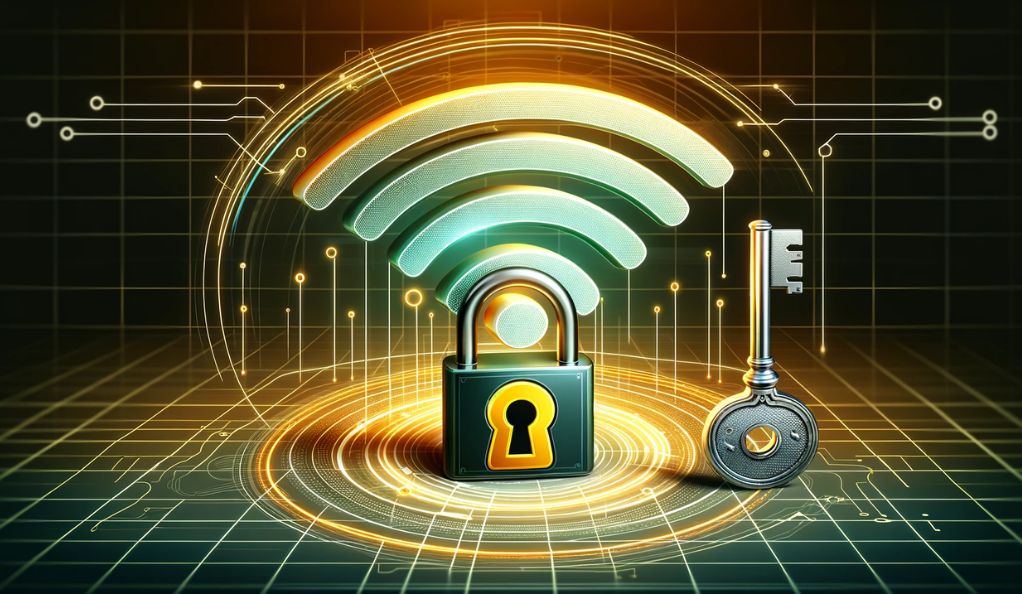Network security keys play a pivotal role in safeguarding our digital lives. As we increasingly rely on internet connectivity, understanding these keys becomes essential. They are the first line of defense in wireless network security, crucial for protecting sensitive data from unauthorized access.
A network security key is akin to a password but for accessing wireless networks. It secures your Wi-Fi connection, ensuring that only authorized users can access it. These keys guard against potential intrusions by encrypting the data transmitted over the network.
What is a Network Security Key?
A network security key is a critical component in the world of internet connectivity, particularly in wireless networks. It functions much like a lock and key mechanism, where the key is a secret code or password that grants access to the wireless network. This key plays a crucial role in preventing unauthorized access, ensuring that the network remains secure and private.

Definition and Purpose of Network Security Keys
Network security keys are essentially passwords or digital handshakes that establish a secure connection between a device and a wireless network. Their primary purpose is to protect the network’s integrity by encrypting data during transmission. This encryption ensures that sensitive information like login credentials, financial data, and personal emails are not intercepted or compromised by unauthorized individuals.
Types of Network Security Keys
Understanding the different types of network security keys is essential for choosing the right one for your needs. The three most common types are:
- WEP (Wired Equivalent Privacy): This is the oldest form of encryption for wireless networks. However, due to its lower security level, it’s less common now.
- WPA (Wi-Fi Protected Access): WPA was developed as a more secure replacement for WEP. It uses stronger encryption methods, making it harder to hack.
- WPA2 (Wi-Fi Protected Access 2): The most advanced and secure option available. WPA2 uses the strongest encryption techniques, providing the highest level of security for wireless networks.
Selecting the right type of security key is crucial for ensuring your network’s safety. WPA2 is highly recommended for most users due to its robust security features.
The Role of Network Security Keys in WiFi Protection
Network security keys are the unsung heroes in the realm of WiFi protection. As we connect various devices to wireless networks, from smartphones to laptops, the security of these connections becomes paramount. Network security keys are the tools that maintain this security, providing a robust defense against unauthorized access and potential cyber threats.
How Network Security Keys Function in WiFi Networks
The function of network security keys in WiFi networks is twofold: authentication and encryption. When a device attempts to connect to a WiFi network, it must provide the correct network security key. This key acts as a form of authentication, ensuring that only authorized users can access the network. Once the device is authenticated, the network security key also encrypts the data being transmitted to and from the device. This encryption is vital in protecting the data from being intercepted or misused by cybercriminals.
Importance of Network Security Keys for WiFi Safety
The importance of network security keys for WiFi safety cannot be overstated. In today’s digital age, where data breaches and cyber attacks are increasingly common, a strong network security key is essential for:
- Protecting Personal Information: It helps keep personal information like emails, passwords, and financial data secure.
- Preventing Unauthorized Access: A robust network security key ensures that only authorized users can access your network, keeping out potential hackers.
- Maintaining Network Integrity: It helps in maintaining the overall health and integrity of your WiFi network, ensuring smooth and secure connectivity for all users.
In essence, a network security key is a critical element in maintaining a safe and secure WiFi environment. Its role in protecting both personal and corporate data is invaluable in our interconnected world.
Discovering Your Network Security Key
Knowing how to find your network security key is essential for managing and securing your WiFi network. Whether you are setting up a new device or troubleshooting a connection issue, having easy access to this key is crucial. This section will guide you through the steps to locate your network security key and explain how it differs from a regular password.
Guide on How to Find Your Network Security Key
Finding your network security key is usually straightforward. Here’s how you can locate it:
- Check Your Router: The easiest place to start is by checking your wireless router. Often, the network security key is printed on a label attached to the router.
- Router’s Administrative Page: Access your router’s settings by typing its IP address into a web browser. Once logged in, you can find the network security key under the wireless security settings.
- User Manual or ISP: If you’re still unsure, check the user manual that came with your router, or contact your Internet Service Provider (ISP) for assistance.
Remember, you’ll need the admin password for your router to access the settings. This is different from your network security key.
Difference Between Network Security Key and Password
It’s important to distinguish between a network security key and a password:
Network Security Key: This is specifically used to connect devices to a WiFi network. It ensures that the connection and data transferred over the network are secure.
Password: In a broader sense, a password is a string of characters used for authentication to gain access to resources. This includes your router’s admin page, email accounts, and various online services.
Understanding this difference is vital in managing your network’s security effectively. While the network security key secures your WiFi network, passwords protect various accounts and devices from unauthorized access.
Network Security Keys for Various Devices
In the diverse world of digital devices and routers, understanding how to manage network security keys across different platforms is crucial. Each device or router has its unique method of accessing and setting up these keys. This section provides clear guidelines for locating and setting up network security keys on a variety of devices, ensuring your network remains secure no matter what hardware you use.
How to Locate Network Security Keys on Different Routers
Locating the network security key on different routers involves specific steps depending on the brand and model. Here are some general guidelines:
- Consult the Router Label: Most routers have a label on the bottom or side, listing the default network security key.
- Access Router Settings: You can log into your router’s web interface using its IP address. The security key is usually under the ‘Wireless’ or ‘Security’ settings.
- Refer to the Manual: If you’re unsure, the router’s manual often has detailed instructions for finding the security key.
For different router brands like Linksys, Netgear, or TP-Link, the process might have slight variations, but the general approach remains consistent.
Setting Up Network Security Keys on Various Devices
Setting up network security keys on different devices, such as smartphones, laptops, or tablets, is a straightforward process:
- Access WiFi Settings: On the device, go to the WiFi settings.
- Select Your Network: Choose your network from the list of available networks.
- Enter the Network Security Key: When prompted, enter the network security key. This will usually be the key you located or set up on your router.
Remember, each device might have a different way of navigating to these settings, but the overall process is quite similar. Ensuring that your network security key is correctly set up on all devices is key to maintaining a secure and efficient network.
Securing Hotspots with Network Security Keys
In our increasingly mobile world, the use of hotspots for internet connectivity has become commonplace. While they offer convenience, hotspots also pose unique security challenges. Implementing network security keys is a crucial step in ensuring that these wireless access points are not just convenient but also secure.
Importance of Network Security Keys for Hotspot Security
Network security keys are vital in safeguarding hotspots. These keys serve as a barrier, preventing unauthorized users from accessing the network. This is especially important for hotspots, which are often in public places and therefore more susceptible to security breaches. A strong network security key ensures that the data transmitted through these hotspots is encrypted, reducing the risk of cyber threats like data theft or hacking.
Best Practices for Hotspot Security
Ensuring hotspot security involves more than just setting a network security key. Here are some best practices to follow:
- Use Strong Encryption: Opt for WPA2 encryption for your hotspot, as it provides the highest security level.
- Change Default Passwords: Always change the default network security key to something more secure and unique.
- Regularly Update Firmware: Keep the hotspot’s firmware updated to protect against the latest security vulnerabilities.
- Limit Access: If possible, limit the number of devices that can connect to your hotspot.
- Monitor Connected Devices: Regularly check which devices are connected to your hotspot and disconnect any unknown devices.
By following these practices, you can significantly enhance the security of your hotspot, ensuring that your internet connection remains safe and private.
Troubleshooting Common Network Security Key Issues
Encountering issues with network security keys can be a common frustration in the management of wireless networks. Whether it’s a connection problem or a forgotten key, understanding how to troubleshoot these issues is essential. This section aims to guide you through common network security key problems and provide practical solutions.
Common Problems and Solutions Related to Network Security Keys
Several issues can arise with network security keys, but thankfully, most have straightforward solutions:
- Incorrect Key Error: Ensure you’re entering the correct key. Remember, they are case-sensitive.
- Connection Drops: This can be due to distance from the router or interference. Try moving closer to the router or reducing interference from other devices.
- Key Not Working After Router Update: Sometimes, updating your router’s firmware can reset its settings. Re-enter the network security key if this happens.
These are just a few examples, but they represent the most common issues users face with network security keys.
Tips for Resetting or Recovering Lost Keys
If you’ve lost your network security key or need to reset it, here are some tips:
- Check the Router: Many routers have the default key printed on them. Check the label on your router.
- Access Router Settings: You can log into your router’s interface and view or reset the network security key under the wireless settings.
- Factory Reset: If all else fails, performing a factory reset on your router will restore the default settings, including the network security key. However, remember that this will erase all your current settings.
By familiarizing yourself with these troubleshooting tips, you can effectively manage and resolve most issues related to network security keys. This knowledge is invaluable in maintaining a secure and reliable wireless network.
Enhancing Your Network’s Security
In an era where cyber threats are ever-evolving, merely setting up a network security key is not enough. It’s crucial to take further steps to enhance the overall security of your network. This involves implementing advanced security measures and regularly updating your network configurations to protect against potential vulnerabilities.

Advanced Tips for Strengthening Your Network Security
To further bolster your network security, consider the following advanced tips:
- Enable Network Encryption: Use WPA3 encryption if your router supports it, as it’s the most secure.
- Turn Off WPS (Wi-Fi Protected Setup): Although convenient, WPS can be a security risk. Disable it to prevent unauthorized access.
- Create a Guest Network: This keeps your main network more secure by isolating guest users.
- Use MAC Address Filtering: This feature allows only recognized devices to connect to your network.
- Disable Remote Management: Turning off remote access to your router’s settings can prevent external hacking attempts.
These measures provide an additional layer of security, greatly reducing the risk of unauthorized access and data breaches.
Importance of Regular Updates and Secure Configurations
Keeping your network secure also means staying up-to-date:
- Regularly Update Firmware: Router manufacturers often release firmware updates that include security patches. Regularly updating your router’s firmware can protect against new vulnerabilities.
- Change Default Admin Credentials: The default usernames and passwords for router admin are often well-known and can be a security risk. Change them to something unique and strong.
- Regularly Change Network Security Keys: Changing your network security key periodically can prevent long-term unauthorized access.
- Monitor Network Activity: Regularly check for unknown devices or unusual activity on your network.
Consistent updates and vigilant configuration management are key to maintaining a secure network. By implementing these practices, you can ensure that your network remains safe from emerging cyber threats and vulnerabilities.
Conclusion
In conclusion, the significance of network security keys extends far beyond basic access to wireless networks; they are fundamental in safeguarding our digital interactions. In an era marked by escalating cyber threats, a robust understanding and meticulous management of these keys are not just recommended, but essential. They act as a critical barrier, defending our personal and financial information from unauthorized breaches. This discussion underscores the importance of being proactive and well-informed in our approach to network security. By doing so, we not only protect our individual networks but also contribute to the broader goal of creating a more secure and trustworthy digital landscape. In essence, network security keys are not merely technical tools; they are vital components in maintaining the integrity and safety of our increasingly connected world.








